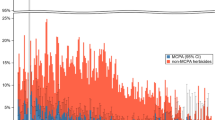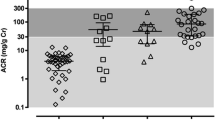Abstract
Background
The herbicide paraquat (1, 1′-dimethyl-4, 4′-bipyridylium dichloride; PQ) is a poison well-known to cause delayed mortality due to acute kidney injuries (AKI). This study examines the changes in serum amino acids (AAs) metabolite profiles as surrogate markers of renal cell metabolism and function after paraquat poisoning.
Methods
To identify the metabolic profiling of free serum AAs and its metabolites, serum from 40 paraquat-poisoned patients with or without AKI is collected. LC-MS/GC-MS is performed to analyze AA molecules. A Cox proportional hazard model was used to assess for incidence of AKI. Receiver operating characteristic (ROC) curve is applied to evaluate AKI occurrence and prognosis.
Results
A total of 102 serum AAs and its metabolites were identified. Compared with non-AKI patients, 37 varied significantly in AKI patients. The univariate Cox proportional hazard model analysis revealed that the estimated PQ amount, plasma PQ concentration, urine PQ concentration, APACHE, SOFA scores and 16 amino acids correlated with the incidence of AKI. Further analyses revealed that 3-methylglutarylcarnitine, 1-methylimidazoleacetate, and urea showed higher cumulative hazard ratios for the occurrence of AKI during follow-up (P < 0.05). The area under the curve (AUC) of 3-methylglutarylcarnitine, 1-methylimidazoleacetate and urea were 0.917, 0.857, 0.872, respectively.
Conclusion
3-methylglutarylcarnitine, 1-methylimidazoleacetate and urea were associated with AKI in patients with paraquat intoxication.


Similar content being viewed by others
References
Gunnell D, Eddleston M. Suicide by intentional ingestion of pesticides: a continuing tragedy in developing countries. Int J Epidemiol. 2003;32(6):902.
Eddleston M, Phillips MR. Self poisoning with pesticides. Bmj. 2004;328(7430):42–4.
Rose MS, Smith LL. Tissue uptake of paraquat and diquat. Gen Pharmacol. 1977;8(3):173–6.
Hawksworth GM, Bennett PN, Davies DS. Kinetics of paraquat elimination in the dog. Toxicol Appl Pharmacol. 1981;57(2):139.
Smith LL. Mechanism of paraquat toxicity in lung and its relevance to treatment. Hum Toxicol. 1987;6(1):31–6.
Haley TJ. Review of the toxicology of paraquat (1,1′-dimethyl-4,4′-bipyridinium chloride). Clin Toxicol. 1979;14(1):1–46.
Lin JL, Liu L, Leu ML. Recovery of respiratory function in survivors with paraquat intoxication. Arch Environ Health. 1995;50(6):432–9.
Li LR, Sydenham E, Chaudhary B, Beecher D, You C. Glucocorticoid with cyclophosphamide for paraquat-induced lung fibrosis. Cochrane Database Syst Rev. 2014(8):Cd008084.
Gill N, Nally JV Jr, Fatica RA. Renal failure secondary to acute tubular necrosis: epidemiology, diagnosis, and management. Chest. 2005;128(4):2847–63.
Uchino S, Kellum JA, Bellomo R, Doig GS, Morimatsu H, Morgera S, et al. Acute renal failure in critically ill patients: a multinational, multicenter study. Jama. 2005;294(7):813–8.
Molck AM, Friis C. The cytotoxic effect of paraquat to isolated renal proximal tubular segments from rabbits. Toxicology. 1997;122(1–2):123–32.
Ishii K, Adachi J, Tomita M, Kurosaka M, Ueno Y. Oxysterols as indices of oxidative stress in man after paraquat ingestion. Free Radic Res. 2002;36(2):163–8.
Senator A, Rachidi W, Lehmann S, Favier A, Benboubetra M. Prion protein protects against DNA damage induced by paraquat in cultured cells. Free Radic Biol Med. 2004;37(8):1224–30.
Van Vleet TR, Schnellmann RG. Toxic nephropathy: environmental chemicals. Semin Nephrol. 2003;23(5):500–8.
Maxvold NJ, Smoyer WE, Custer JR, Bunchman TE. Amino acid loss and nitrogen balance in critically ill children with acute renal failure: a prospective comparison between classic hemofiltration and hemofiltration with dialysis. Crit Care Med. 2000;28(4):1161–5.
KDIGO. KDIGO clinical practice guideline for acute kidney injury. Kidney Int Suppl. 2012;2(1):1–138.
Fujii T, Uchino S, Takinami M, Bellomo R. Validation of the kidney disease improving global outcomes criteria for AKI and comparison of three criteria in hospitalized patients. Clin J Am Soc Nephrol. 2014;9(5):848–54.
Greene KE, Peters JI. Pathophysiology of acute respiratory failure. Clin Chest Med. 1994;15(1):1–12.
Roussos C, Koutsoukou A. Respiratory failure. Eur Respir J Suppl. 2003;47:3 s–14 s.
Lin JL, Leu ML, Liu YC, Chen GH. A prospective clinical trial of pulse therapy with glucocorticoid and cyclophosphamide in moderate to severe paraquat-poisoned patients. Am J Respir Crit Care Med. 1999;159(2):357–60.
Hong SY, Gil HW, Yang JO, Lee EY, Na JO, Seo KH, et al. Clinical implications of the ethane in exhaled breath in patients with acute paraquat intoxication. Chest. 2005;128(3):1506–10.
Whitehead RD, Montesano MA, Jayatilaka NK, Buckley B, Winnik B, Needham LL, et al. Method for measurement of the quaternary amine compounds paraquat and diquat in human urine using high-performance liquid chromatography-tandem mass spectrometry. J Chromatogr B Anal Technol Biomed Life Sci. 2010;878(27):2548–53.
Zhou CY, Kang X, Li CB, Li XH, Liu Y, Wang Z, et al. Pneumomediastinum predicts early mortality in acute paraquat poisoning. Clin Toxicol (Phila). 2015;53(6):551–6.
Seymour CW, Yende S, Scott MJ, Pribis J, Mohney RP, Bell LN, et al. Metabolomics in pneumonia and sepsis: an analysis of the GenIMS cohort study. Intensive Care Med. 2013;39(8):1423–34.
Wunnapuk K, Medley GA, Liu X, Grice JE, Jayasinghe S, Gawarammana I, et al. Simple and sensitive liquid chromatography-tandem mass spectrometry methods for quantification of paraquat in plasma and urine: application to experimental and clinical toxicological studies. J Chromatogr B Analyt Technol Biomed Life Sci. 2011;879(28):3047–52.
Lawton KA, Berger A, Mitchell M, Milgram KE, Evans AM, Guo L, et al. Analysis of the adult human plasma metabolome. Pharmacogenomics. 2008;9(4):383–97.
Dehaven CD, Evans AM, Dai H, Lawton KA. Organization of GC/MS and LC/MS metabolomics data into chemical libraries. J Cheminform. 2010;2(1):9.
Cox DR. Regression Models and Life-Tables. J Roy Stat Soc. 1972;34(2):187–220.
Li LR, Sydenham E, Chaudhary B, You C. Glucocorticoid with cyclophosphamide for paraquat-induced lung fibrosis. Cochrane Database Syst Rev. 2014;8(6):-.
Roe CR, Millington DS, Maltby DA. Identification of 3-methylglutarylcarnitine. A new diagnostic metabolite of 3-hydroxy-3-methylglutaryl-coenzyme A lyase deficiency. J Clin Investig. 1986;77(4):1391.
Schulz H. Beta oxidation of fatty acids. Biochimica Et Biophysica Acta. 1991;1081(2):109–20.
Ahmad S. l-carnitine in dialysis patients. Semin Dial. 2001;14(3):209–17.
Borum PR. Carnitine. Determination of total carnitine using a radioenzymatic assay. J Nutr Biochem. 1990;1(2):111.
Hermann K, Hertenberger B, Ring J. Measurement and characterization of histamine and methylhistamine in human urine under histamine-rich and histamine-poor diets. Int Arch Allergy Immunol. 1993;101(1):13–9.
Johansson AC, Lönnqvist B, Granerus G. The relationship between body size and the urinary excretion of the main histamine metabolite tele-methylimidazoleacetic acid in man. Inflamm Res. 2001;50(2):70–1.
Johansson AC, Lonnqvist B, Granerus G. The relationship between body size and the urinary excretion of the main histamine metabolite tele-methylimidazoleacetic acid in man. Inflamm Res. 2001;50(Suppl 2):70-1.
Madjene LC, Pons M, Danelli L, Claver J, Ali L, Madera-Salcedo IK, et al. Mast cells in renal inflammation and fibrosis: lessons learnt from animal studies. Mol Immunol. 2015;63(1):86–93.
Oka T, Kalesnikoff J, Starkl P, Tsai M, Galli SJ. Evidence questioning cromolyn’s effectiveness and selectivity as a ‘mast cell stabilizer’ in mice. Lab Investig J Tech Methods Pathol. 2012;92(10):1472.
Madjene LC, Pons M, Danelli L, Claver J, Ali L, Madera-Salcedo IK, et al. Mast cells in renal inflammation and fibrosis: lessons learnt from animal studies. Mol Immunol. 2014.
Oka T, Kalesnikoff J, Starkl P, Tsai M, Galli SJ. Evidence questioning cromolyn’s effectiveness and selectivity as a ‘mast cell stabilizer’ in mice. Lab Invest. 2012;92(10):1472–82.
Moore AE, Johnston WH, Hever A, Peng S, Kujubu DA. Systemic mastocytosis presenting with acute oliguric renal failure: report of a case and review of the literature. Int Urol Nephrol. 2012;44(2):639–42.
Talaszka A, Boulanger E, Le Monies de Sagazan H, Le Blan C. Acute kidney failure revealing mastocytosis. Presse Med. 1992;21(19):908–9.
Fenton RA, Knepper MA. Urea and renal function in the 21st century: insights from knockout mice. J Am Soc Nephrol Jasn. 2007;18(3):679–88.
Varela CF, Greloni G, Schreck C, Bratti G, Medina A, Marenchino R, et al. Assessment of fractional excretion of urea for early diagnosis of cardiac surgery associated acute kidney injury. Ren Fail. 2015;37(10):327–31.
Fenton RA, Knepper MA. Urea and renal function in the 21st century: insights from knockout mice. J Am Soc Nephrol. 2007;18(3):679–88.
Ring T. Urea handling in acute renal failure. Kidney Int. 2012;82(10):1137. (Author reply-8)
Acknowledgements
This work received the support of grants from the National Natural Science Foundation of China Nos: 81270136, 81671897 (to A.P.), No: 81500508 (to H.B.), Shanghai Pujiang Program No: 15PJ1406800 (to H.B.), Shanghai international cooperation program No: 16410724200 (to H.B.). The funders had no role in study design, data collection and analysis, decision to publish, or preparation of the manuscript.
Author information
Authors and Affiliations
Corresponding author
Ethics declarations
Conflict of interest
The authors declared that they have no conflict of interest.
Additional information
Publisher’s Note
Springer Nature remains neutral with regard to jurisdictional claims in published maps and institutional affiliations.
Electronic supplementary material
Below is the link to the electronic supplementary material.
About this article
Cite this article
Wan, X., Li, X., Wang, Q. et al. Metabolitic profiling of amino acids in paraquat-induced acute kidney injury. Clin Exp Nephrol 23, 474–483 (2019). https://doi.org/10.1007/s10157-019-01702-z
Received:
Accepted:
Published:
Issue Date:
DOI: https://doi.org/10.1007/s10157-019-01702-z




